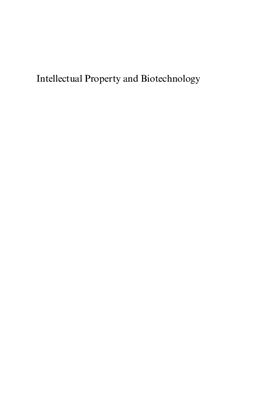Издательство Edward Elgar, 2008, -392 pp.
In the nineteenth century, patent law provided exclusive rights to inventors in respect of mechanical inventions, but it did not extend such protection to biological inventions. My mother’s family hail from Shepparton in the Goulbu Valley in Victoria, Australia. In 1873, the blacksmith, John Furphy, set up a forge in the town, and produced a range of farm machinery. He was awarded a Victorian colonial patent in respect of a ‘grain stripping machine’ in 1882.2 The invention won first prize at the Grand National Show in 1884, and enjoyed great popularity at agricultural fairs. The Furphy Foundry became most famous for the Furphy Water Cart, with its catchy advertising slogan, ‘Good, better, best/ Never let it rest/ Until your good is better/ And your better best.’ After the Water Cart was used by the Australian army in World War I, the word ‘furphy’ became a byword for gossip, idle rumour and tall stories. John’s brother, Joseph Furphy, wrote the classic work of Australian literature, Such is Life, while working at the foundry.3 The Furphy family were inventive in both the arts and the sciences. Since the time of John and Joseph Furphy, patent law has become unrecognizable. With federation, the Australian Federal Govement gained the exclusive power to make laws with respect to intellectual property, including patents of invention. Moreover, the Australian Patents Act 1990 (Cth) has been heavily influenced by inteational treaties, such as the TRIPS Agreement 1994, and the Australia–United States Free Trade Agreement 2004. Once the province of mechanical inventions and chemicals, patent law has expanded in its scope to cover all sorts of biological inventions, including micro-organisms, plants and animals; methods of human treatment, pharmaceutical drugs and research tools; and human genes, stem cells and tissues. No doubt, some of these inventions would seem to be farfetched and incredible ‘furphies’. The mechanical engineers of the ilk of John and Joseph Furphy have been joined by new species of inventors: micro-biologists, plant and animal breeders, genetic engineers, stem cell scientists and nanotechnology developers. This book considers how the patent system, a product of the industrial revolution, has accommodated and adapted to the recent developments in the life sciences.
Anything under the sun: patent law and micro-organisms
Franklin barley: patent law and plant breeders’ rights
The human chimera patent initiative: patent law and animals
The storehouse of knowledge: patent law, scientific discoveries and products of nature
The book of life: patent law and the human genome project
The dilettante’s defence: patent law, research tools and experimental use
The Utah saints: patent law and genetic testing
The alchemy of junk: patent law and non-coding DNA
Still life with stem cells: patent law and human embryos
Conclusion. Blue sky research: patent law and frontier technologie
In the nineteenth century, patent law provided exclusive rights to inventors in respect of mechanical inventions, but it did not extend such protection to biological inventions. My mother’s family hail from Shepparton in the Goulbu Valley in Victoria, Australia. In 1873, the blacksmith, John Furphy, set up a forge in the town, and produced a range of farm machinery. He was awarded a Victorian colonial patent in respect of a ‘grain stripping machine’ in 1882.2 The invention won first prize at the Grand National Show in 1884, and enjoyed great popularity at agricultural fairs. The Furphy Foundry became most famous for the Furphy Water Cart, with its catchy advertising slogan, ‘Good, better, best/ Never let it rest/ Until your good is better/ And your better best.’ After the Water Cart was used by the Australian army in World War I, the word ‘furphy’ became a byword for gossip, idle rumour and tall stories. John’s brother, Joseph Furphy, wrote the classic work of Australian literature, Such is Life, while working at the foundry.3 The Furphy family were inventive in both the arts and the sciences. Since the time of John and Joseph Furphy, patent law has become unrecognizable. With federation, the Australian Federal Govement gained the exclusive power to make laws with respect to intellectual property, including patents of invention. Moreover, the Australian Patents Act 1990 (Cth) has been heavily influenced by inteational treaties, such as the TRIPS Agreement 1994, and the Australia–United States Free Trade Agreement 2004. Once the province of mechanical inventions and chemicals, patent law has expanded in its scope to cover all sorts of biological inventions, including micro-organisms, plants and animals; methods of human treatment, pharmaceutical drugs and research tools; and human genes, stem cells and tissues. No doubt, some of these inventions would seem to be farfetched and incredible ‘furphies’. The mechanical engineers of the ilk of John and Joseph Furphy have been joined by new species of inventors: micro-biologists, plant and animal breeders, genetic engineers, stem cell scientists and nanotechnology developers. This book considers how the patent system, a product of the industrial revolution, has accommodated and adapted to the recent developments in the life sciences.
Anything under the sun: patent law and micro-organisms
Franklin barley: patent law and plant breeders’ rights
The human chimera patent initiative: patent law and animals
The storehouse of knowledge: patent law, scientific discoveries and products of nature
The book of life: patent law and the human genome project
The dilettante’s defence: patent law, research tools and experimental use
The Utah saints: patent law and genetic testing
The alchemy of junk: patent law and non-coding DNA
Still life with stem cells: patent law and human embryos
Conclusion. Blue sky research: patent law and frontier technologie

